Report Authors:
- Matthew May, Survey Research Director, School of Public Service
- Lantz McGinnis-Brown, Research Associate Idaho Policy Institute
- Elijah Kuisachor, Graduate Assistant Idaho Policy Institute
Accessibility Statement
Content on this site is monitored for compliance with WCAG 2.0 standards. We are continuously improving the usability of our content and are actively working to provide a more inclusive experience for all. Please, contact the Idaho Policy Institute immediately if you encounter any access barriers, challenges, or require the content in another format to fully access the information.
Report content is available on this page or as a downloadable PDF. An interactive dashboard is also provided. For a list of keyboard shortcuts specific to the Tableau dashboard, please visit Keyboard Accessibility for Tableau Views
To request the topline data and full tab book for any survey, email School of Public Service Survey Research Director Dr. Matthew May at: matthewmay1@boisestate.edu
Request the topline data and full tab book
Download the 8th Annual Statewide Survey (PDF)Read the Eighth Annual Statewide Survey
About the Survey
The Eighth Annual Idaho Public Policy Survey was conducted November 10-17, 2022, and surveyed 1,000 adults who currently live in Idaho. The sample is representative of the state’s population, both geographically and demographically, with a margin of error of +/- 3.1%. The survey covered a wide variety of topics, including the economy, state budgeting, taxes, education, growth, housing, the environment, and crime. GS Strategy Group fielded the survey by cell phone (21%), landline phone (21%), online (32%), and text message (27%).*
*Does not add to 100% due to rounding.
Key Findings
- There is increased pessimism among Idahoans, with the gap between the number of Idahoans who believe the state is heading in the right direction (44%) versus those who believe it is off on the wrong track (41%) falling within the margin of error for the first time in this survey’s history.
- This pessimism extends to the economy, as most Idahoans expect the state’s economic condition to either worsen (37%) over the next two years or stay the same (36%). Additionally, 43% of Idahoans worry about paying their bills “always” or “frequently.”
- Idahoans’ top legislative priority remains Education, followed by Jobs and the economy. Housing took the third spot for the first time, overtaking Healthcare.
- Property tax is a major concern of Idahoans compared to previous years, with it and income tax having switched places as the top priority for tax relief over the past two years. A majority of Idahoans (56%) feel that property taxes are too high.
- There is strong support (82%) for eliminating sales tax on groceries, with favorability topping 80% among all political party identifications.
- When allowed to identify any issue without additional prompts, Academics (an emphasis on critical thinking skills and core classes like English, Math, History, and Science) was identified as Idahoans’ top education priority, followed by Teacher Support (attracting and retaining quality educators and increasing teacher pay).
- Growth remains a major concern for Idahoans, with two-thirds (67%) feeling the state is growing too fast.
Overview
For eight years, the Idaho Public Policy Survey has tracked Idahoans’ opinion of the direction of the state, giving valuable insight on their overall perspective. Results this year continue a more pessimistic view towards the state’s future: while more respondents indicate the state is headed in the right direction (44%), almost as many think it is headed off on the wrong track (41%). For the first time in the survey’s history, the three-point gap between these answers is within the margin-of-error. Republicans (63%) and Independents (43%) were much more likely to say the state is headed in the right direction than Democrats (22%). Men (63%) were also more optimistic than women (36%). Those who moved to Idaho in the last 10 years were evenly split in their assessment (40%), while longtime residents are slightly more optimistic (45% right direction).
Do you think things in Idaho are generally headed in the right direction, or do you feel that things are off on the wrong track?

The economy is another area where Idahoans’ answers indicate a degree of pessimism. When asked about their expectations for economic conditions in the state over the next two years, more Idahoans say they expect it to get worse (37%) or stay about the same (36%) rather than get better (21%). This is a sharp reversal from the last time this question was asked three years ago, with the proportion of Idahoans answering better decreasing 16-points and the proportion answering worse increasing 17-points. Worse economic conditions was the top expectation among Republicans (41%) and Independents (36%), while Democrats were more likely to expect economic conditions to stay the same (42%).
Over the next two years, do you expect the economic condition in Idaho to get better, worse, or stay about the same?
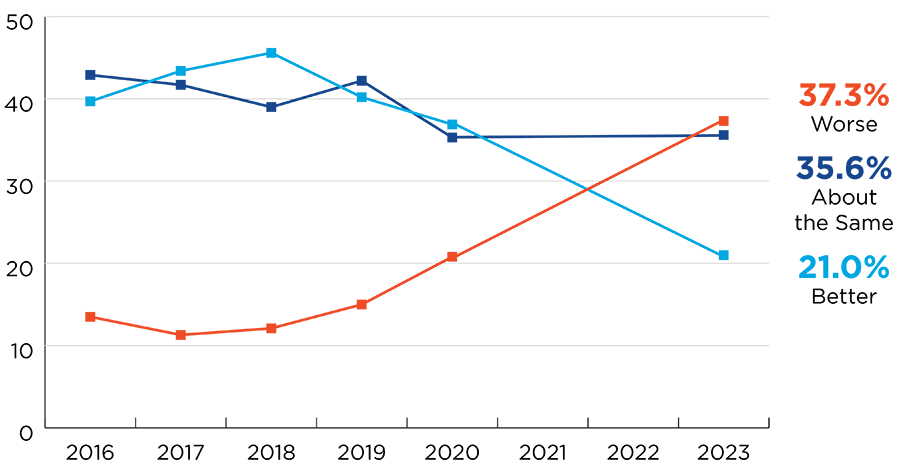
Each year Idahoans are asked to rate policy areas on a scale of 1-10 in terms of how important it is that the Idaho Legislature address that particular issue during the legislative session (1 being not at all important and 10 being extremely important). As in years past, topics include education, the environment, healthcare, housing, jobs and the economy, taxes, and transportation. Respondents were not asked about specific policy preferences in these questions, only to identify which areas they feel most warrant the legislature’s attention.
On a scale of 1-10, with 1 being not at all important and 10 being extremely important, please indicate how important it is for the Idaho State Legislature to address each of the following issues? (% scoring 8-10)
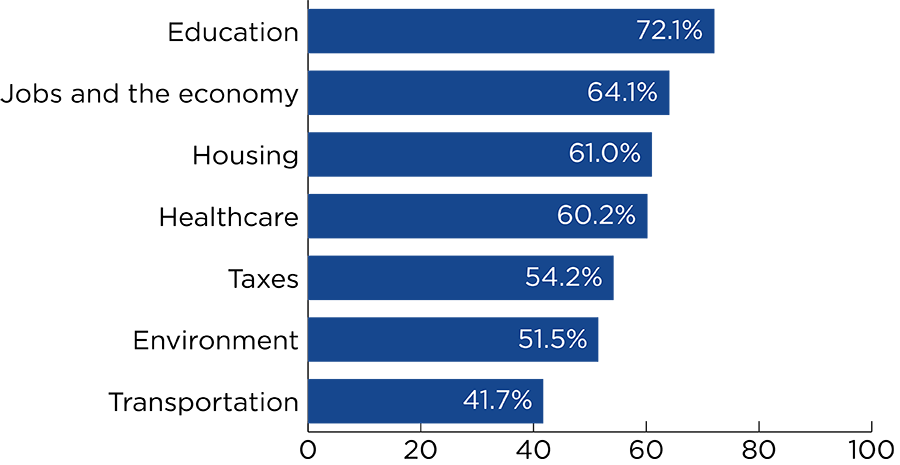
While every issue saw an increase in the proportion scoring it 8-10 compared to last year, the top two legislative priorities remain unchanged: education (72%) and jobs and the economy (64%).
Education has been the top ranked legislative priority for all eight years of this survey. In addition to being the top ranked issue overall, it is also the top issue among both Democrats (86%) and Independents (71%). Among Republicans it ranked second (68%).
The second highest priority, jobs and the economy, has held that placement for the past four years. It is the top priority among Republicans (68%), the second highest among Independents (65%), and the fifth highest among Democrats (55%).
For the first time, housing (61%) rose to the third highest ranked issue overall. It was the third highest priority among Independents (61%) and the fourth highest priority for both Republicans (53%) and Democrats (77%).
Falling to the fourth highest priority overall was healthcare (60%). It is the third highest priority among Democrats (79%), fourth among Independents (61%), and fifth among Republicans (50%).
In fifth place overall was taxes (54%), moving it ahead of the environment among Idahoans’ legislative priorities. The third highest issue among Republicans (64%), taxes were the sixth highest priority among Independents (53%) and the lowest priority among Democrats (38%).
The environment was the sixth highest priority overall (52%), moving down a rank from last year. It is the second highest priority among Democrats (82%), fifth highest among Independents (53%), and lowest priority among Republicans (36%).
Finally, the lowest ranked priority was transportation (42%), which has consistently been outranked by other issues for the past eight years of this survey. It is the sixth highest priority for both Democrats (49%) and Republicans (38%), and the lowest priority among Independents (43%).
Legislative Priorities, 2016-2023 (% scoring 8-10)
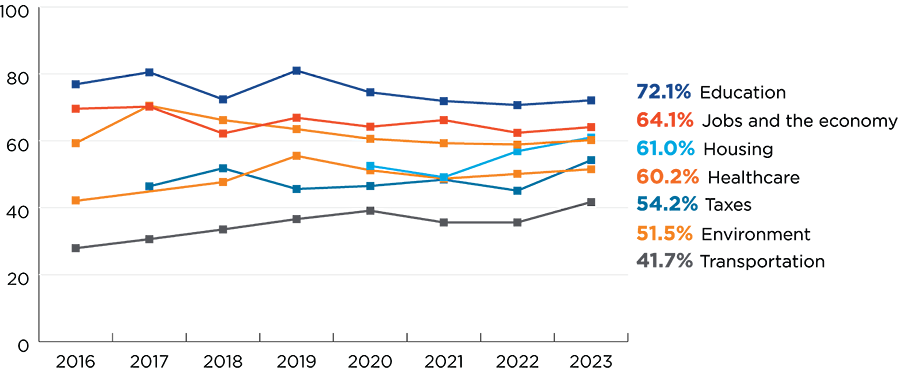
When asked to identify themselves ideologically on a seven-point scale ranging from Very Liberal to Very Conservative, 45% of Idahoans identify themselves as Conservative, while 24% say they are Liberal and 24% Moderate. When subsequently asked to place voters in the state of Idaho overall on the same scale, 74% perceive Idahoans as Conservative, 9% as Liberal, and 11% as Moderate.
Taxes and Budget
The State of Idaho was on track for a $1 billion budget surplus at the time of this survey. As lawmakers consider the best use of that money, we asked Idahoans how they feel the money should be spent among a series of proposals under consideration.
Among the top three responses, giving tax relief to Idahoans received the most support (35%), followed by funding K-12 education (27%) and spending it on workforce and affordable housing (24%). Putting the money in the rainy-day fund (7%) was a distant fourth, while helping to make childcare more affordable (3%) came in last.
Tax relief was the top preference for both Republicans (47%) and Independents (34%), while Democrats most favored funding K-12 education (43%). Workforce and affordable housing was the top choice among renters (43%), but only the third choice among homeowners (16%). Conversely, tax relief was the top choice among homeowners (39%), but the second choice of renters (25%).
The State of Idaho is currently on track for a budget surplus of around $1 billion. Knowing that, which of the following is the best use of that surplus?
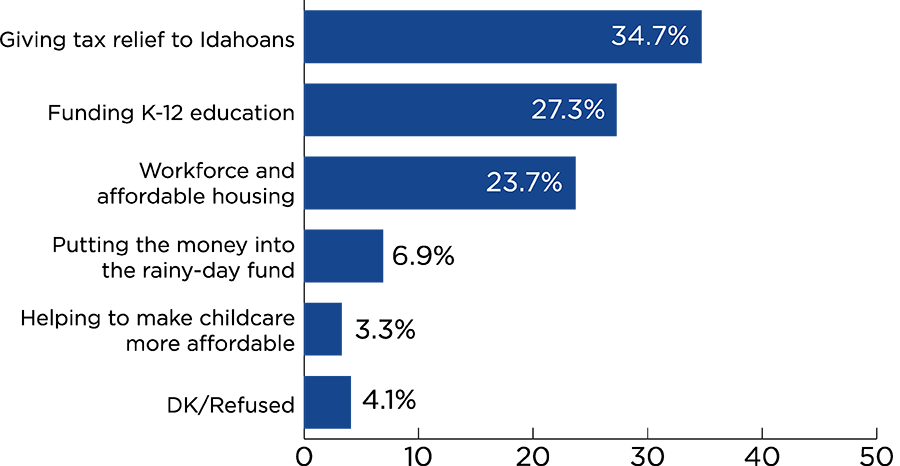
For the past three years we have asked the question, if the budget surplus is used to provide tax relief, which type of tax reduction would provide the most help to Idahoans? When considering the three major types of taxes – property tax, income tax, and sales tax – Idahoans show a strong preference for property tax relief (41%) over income tax (31%), a three-point increase for property taxes over last year and a six-point decrease for income taxes. Sales tax was once again a distant third (22%). Compared to two years ago, property tax relief and income tax relief have switched placement among Idahoans’ preferences. Additionally, property tax was the highest response among all political parties, with 49% of Republicans, 38% of Independents, and 33% of Democrats identifying it as the most preferred tax relief option.
Home ownership has a strong effect on a person’s tax relief preference, with property tax remaining the top choice of homeowners (48%), followed by income tax (27%) and sales tax (21%). Conversely, renters preferred income tax relief (42%), followed by sales tax (27%), and then property tax (20%) the least.
If the budget surplus is used to provide Idahoans with tax relief, which type of tax should be reduced to provide the most help to Idahoans during this time?

Emphasizing Idahoans’ increased concern over property taxes, 56% of Idahoans say that property taxes in Idaho are too high, a 10-point increase over last year, while 32% say they are about right, which is an eight-point decline. Only 2% answered that property taxes are too low. Most areas of the state had majorities expressing concern over property tax levels, although respondents in Twin Falls County (70%) and Canyon County (62%) were the highest. Home ownership played less of a role in responses to this question, with majorities of both homeowners (57%) and renters (51%) saying property taxes in Idaho are too high. Similarly, too high was the top response among Republicans (64%), Independents (52%), and Democrats (49%).
In general, would you say that property taxes in Idaho are too high, too low, or about right?

Another common tax policy proposal is eliminating sales tax on grocery items – that is, the sales tax charged on food items like fruits, vegetables, meat, bread, and dairy. Currently, this basket of goods is taxed in Idaho and residents receive an income tax credit to offset the cost. When asked whether they would favor or oppose a plan to eliminate the grocery tax in Idaho, an overwhelming majority (82%) said they would favor that plan, while only 12% opposed it. Support was strong among both renters (81%) and homeowners (83%), and among all political parties – Republicans (83%), Independents (84%), and Democrats (80%).
Would you favor or oppose a plan to eliminate the grocery tax in Idaho, that is, the sales tax charged on food items like fruits, vegetables, meat, bread, and dairy?
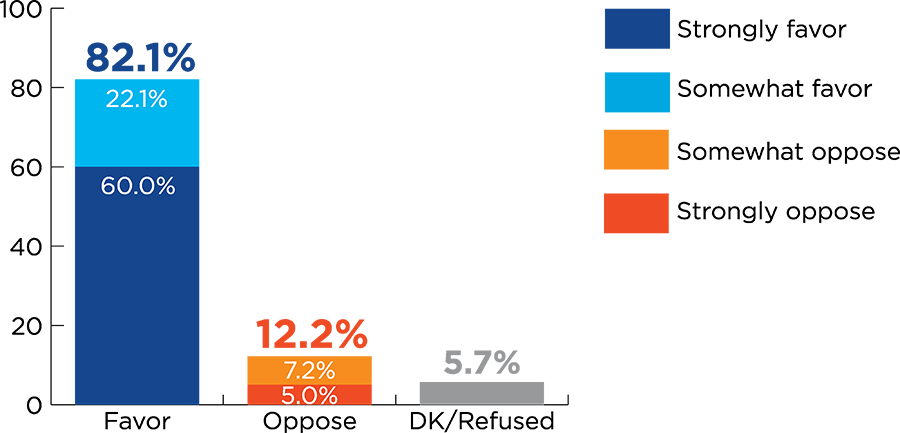
Another tax proposal that is under discussion in state legislatures across the country concerns federal student loan forgiveness – up to $20,000 if borrowers meet certain conditions – and whether that money should be taxed by the states. While some states have chosen to charge state income tax on the amount forgiven, Idaho has yet to weigh in. Idahoans are largely split on the issue.
When asked which came closer to their opinion, 46% said that those who receive student loan forgiveness should pay taxes on that money, while 43% said that student loan forgiveness money should be given to people tax free. These responses fall within the survey’s margin of error, meaning we cannot say conclusively which option Idahoans prefer. These results suggest there is a strong difference of opinion among Idahoans, while 12% remain undecided.
There is a strong party effect on responses. Democrats strongly favor a tax free option (75%), while Independents are largely split between either option (45% tax free, 44% taxed), and Republicans strongly favor taxing the loan forgiveness (67%).
Support for making student loan forgiveness tax free is also strongly correlated with age. Support is strongest among those aged 18-39 (51%), but declines as age increases to 40-64 years (42%) and those aged 65+ (27%). Similarly, those who are retired are more likely to support taxing student loan forgiveness (59%) compared to those currently working (42%). Likewise, renters are more likely to favor tax free (59%) than homeowners (37%).
Recently the federal government announced student loan forgiveness of up to $20,000 if you meet certain conditions. Knowing this, which of the following comes closer to your opinion?
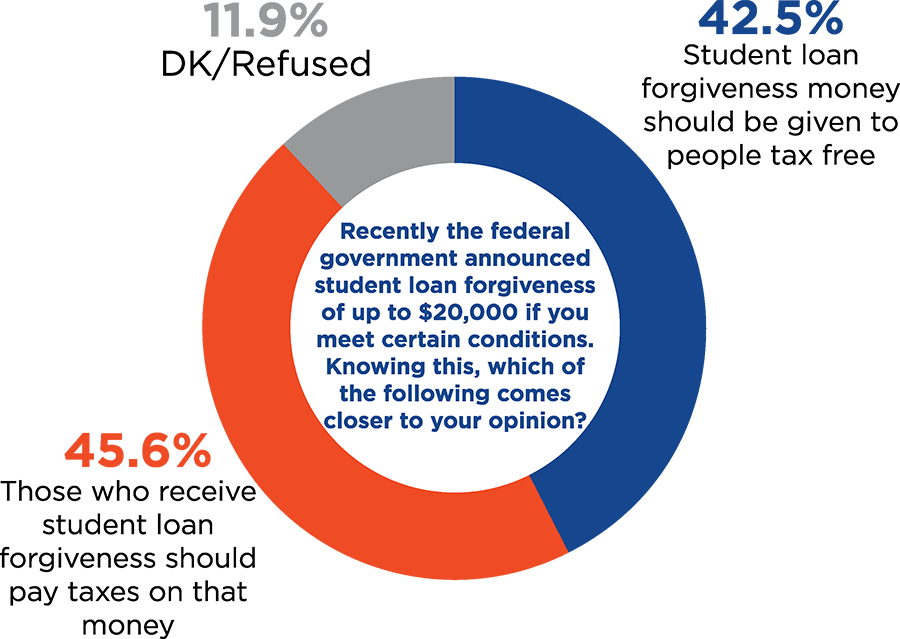
We once again asked Idahoans if they would favor or oppose a plan for the state to offer an incentive or grant for private businesses to provide on-site daycare to allow for more flexibility in the workforce. Support remains high, with 71% of Idahoans supporting the proposal, a five-point increase over last year, while 19% oppose – a six-point decline. Compared to last year, most of the shift is attributable to a five-point decrease in those who somewhat oppose and a corresponding four-point increase in those who somewhat favor. Once again, support exceeded 60% for all political parties, with it strongest among Democrats (86%), then Independents (73%), and Republicans (64%). Parental status did not substantially impact responses.
Would you favor or oppose a plan to give an incentive or grant to private businesses to provide on-site daycare?
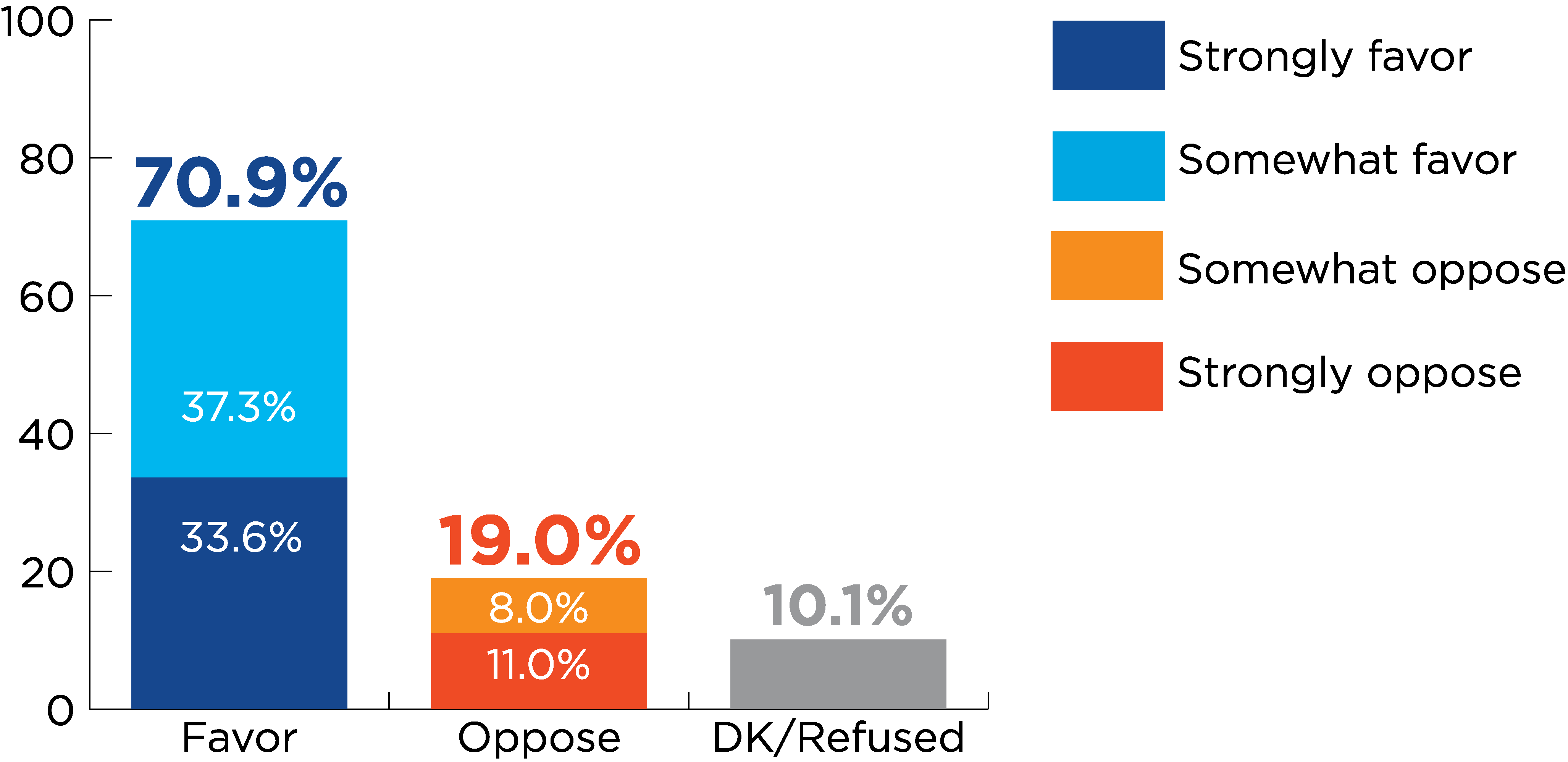
Education
Each year, we ask Idahoans to rate the quality of education in Idaho’s K-12 public schools both statewide and in their own district using a scale of excellent, good, fair, or poor. When it comes to the statewide K-12 system, there is little movement in Idahoans’ assessment – all shifts fall within the margin of error. Once again most Idahoans (35%) rate it as fair, consistently the highest response in each annual survey. A split between good (27%) and poor (27%) ratings follows, both of which have alternated placement over the last five years and been statistically tied for the past two. Finally, only 4% of Idahoans rate the quality of K-12 public schools statewide as excellent.
Majorities of all party identifications provided an unfavorable assessment by rating K-12 public schools as either fair or poor, with Democrats (72%) being the most critical, followed by Independents (66%) and Republicans (53%). Conversely, Republicans were most likely to hold a positive view, with 38% rating them excellent or good, followed by Independents (30%) and Democrats (25%). Respondents with children or grandchildren in K-12 schools in Idaho had similar opinions on Idaho’s education quality to those without.
How would you rate the quality of education in Idaho’s K-12 public schools?

When asked specifically about their own school districts, respondents were slightly more positive. Once again, the change in most responses relative to last year fall within the margin of error, with 10% rating it as excellent, 34% as good, 31% as fair, and 18% as poor. Only the four-point decline in the excellent rating falls outside the margin.
Once again Republicans had the most favorable view, with half (50%) rating the public schools in their own district excellent or good, followed by Democrats (46%) and Independents (40%). Parents and grandparents with children in Idaho schools had more positive attitudes toward their own school district than non-parents, with 12% rating it as excellent, 39% as good, 32% as fair, and 15% poor.
Thinking specifically about your school district, how would you rate the quality of K-12 public schools in your area?

While education has been identified as the top legislative priority of Idahoans over the past eight years, the topic of education covers a wide variety of issues and which of those issues, specifically, Idahoans most care about is not clear by that ranking alone. As such, we asked Idahoans to identify what they thought should be the top priority for K-12 public education in Idaho. This question was left open ended and respondents were free to answer any way they wished. Responses largely fell into six broad categories: academics, academic quality, funding, policy/programmatic changes, teacher support, and other.
Idahoans’ top response was academic content (25%), a category that covered responses calling for more courses, an emphasis on core subjects like English, Math, History, and Science, better curriculum, and teaching critical thinking skills. This was followed by teacher support (17%), which encompassed responses calling for more teachers to be hired, attracting and retaining quality educators, and increasing teacher pay.
The third highest response category was academic quality (13%), which included responses calling for improved education of students overall, lowering student-to-teacher ratios, providing more opportunities for one-on-one instruction, improving test scores, and increasing graduation rates. Policy/programmatic changes (10%) was the fourth ranked category and included responses calling for less censorship, more charter schools, school choice programs, increased parental rights, limiting instruction to exclude certain subject matter, or calls to keep politics out of the classroom. Responses that fell under the funding (10%) category followed closely in fifth place. These included calls for more buildings or infrastructure in our education system, increased public funding, implementation of all-day kindergarten, and improving technological resources available to schools.
The remainder of responses fell under the other (9%) categorization and included calls for greater accountability, elimination of teacher unions, free school lunch, stopping bullying, and mitigating the impact of the COVID-19 pandemic on public education.
For the most part, the priorities of those with children or grandchildren in Idaho schools were not dissimilar to those without – academics, teacher support, and academic quality were the top three priorities for both groups, in that order. That said, while funding was the fourth highest priority among parents and grandparents (17%), it was the lowest priority for non-parents (8%), who instead favored policy/programmatic change (10%) as their fourth ranked priority.
1In your opinion what is the top priority for K-12 public education in Idaho? [open ended]
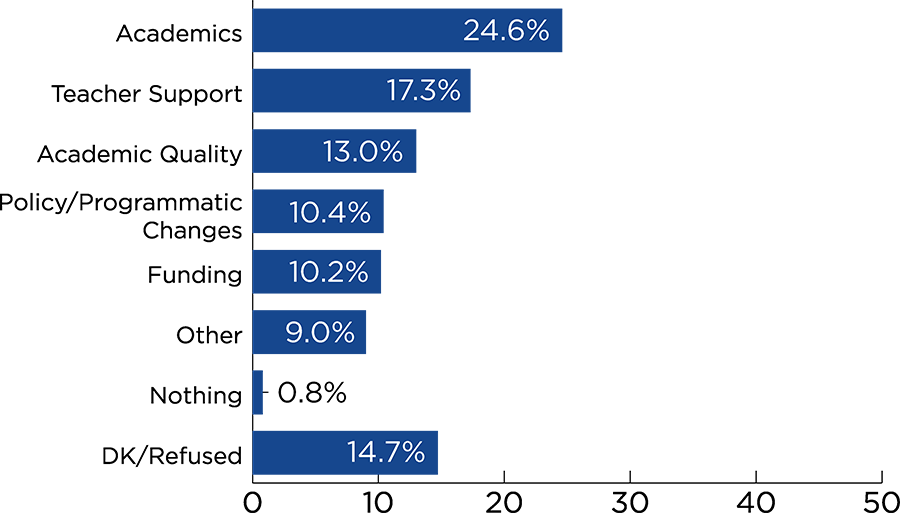
An education proposal currently under consideration concerns the subject of school choice, or allowing parents to take money out of the public school system (approximately $8,000 per student in Idaho) and use it to enroll their child in a private school.
When asked if they would favor or oppose taking money out of the public school system and using it to enroll their child in a charter, private, or religious school, Idahoans were somewhat split, but leaned more in favor of the plan (49%) than opposed (43%), although many were unsure (9%). Note that the language of this question unfortunately contained a factual error by including charter schools, which are considered public schools in Idaho and do not charge tuition. As such, money under this proposal could not actually be used to enroll students in a charter school and its inclusion may have impacted individuals’ responses.
Right now, in Idaho, the state government spends about $8,000 per student to pay for K-12 public schools. Would you favor or oppose a school choice plan to allow Idaho parents to take that $8,000 out of the public school system and use it to enroll their child in a charter, private, or religious school?*
*Inclusion of charter schools in error may have impacted responses.
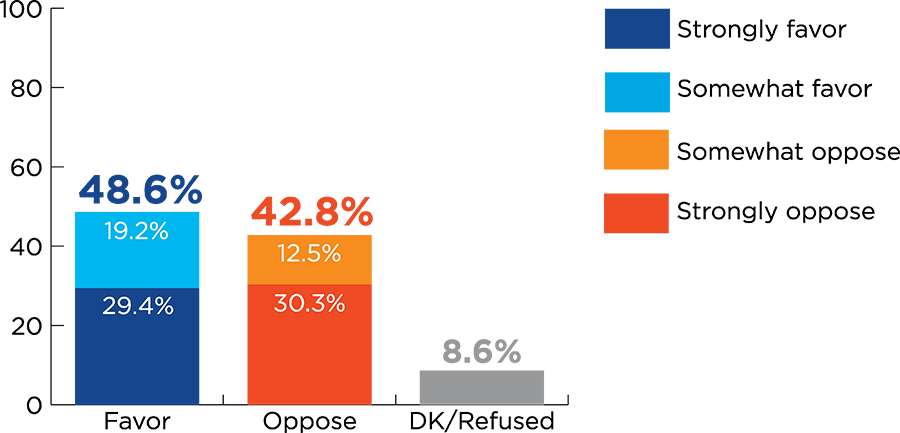
There is a strong party effect on support for this proposal. Republicans are most supportive, with 60% in favor, followed by a majority of Independents (51%). Conversely, Democrats are overwhelmingly opposed (77%). On the other hand, parents/grandparents and non-parents were not appreciably different in their responses.
Depending on how a school choice policy is written, some public school districts could be left with lower overall budgets. We asked Idahoans how that would impact their level of support. A number of Idahoans (44%) said it would make them less supportive of the proposal, while a little over a third (34%) said it would have no impact on their level of support. Only 14% said it would make them more supportive.
If you knew that this plan could leave some public school districts with lower overall budgets, would that make you…
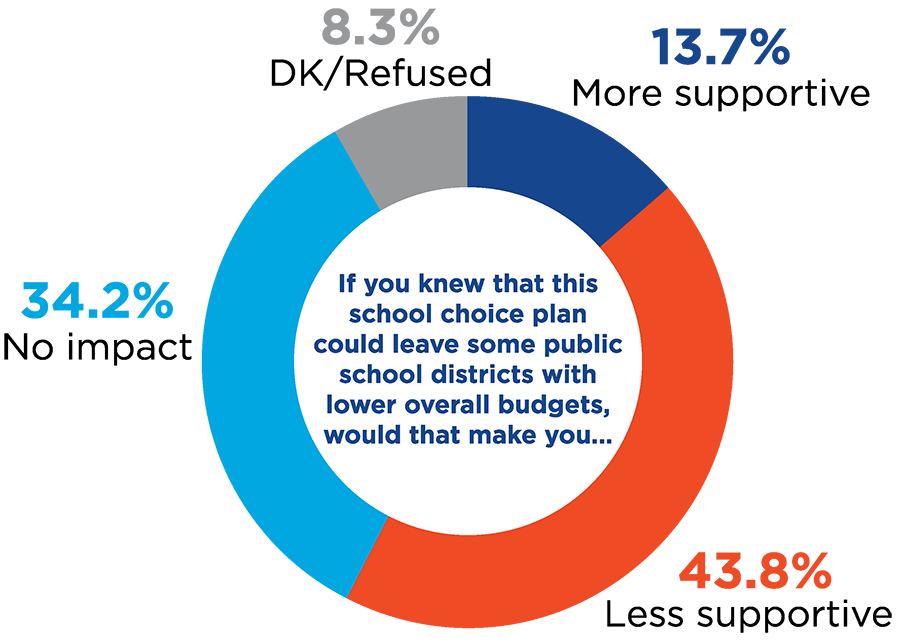
Analyzing these two questions together is useful, as it reveals where that increased or decreased support originated. Did it make those in favor less supportive or those opposed more supportive? In part. Almost a quarter (24%) of those who said they favored the proposal said its impact on public school district budgets made them less supportive. At the same time, several of those opposed (9%) said it made them more supportive. Taken together, this suggests support for the proposal may be more limited than first thought.
Next, we asked Idahoans to share their level of agreement with the statement, “Overall, I feel that Idaho schools are safe.” A large majority of Idahoans (78%) agreed with that statement, while 16% disagreed. While agreement was high across all groups, men (85%) were somewhat more likely to agree than women (72%) and parents/grandparents were more likely to agree (81%) than non-parents (77%).
Please indicate [your level of agreement] with the following statement: Overall, I feel that Idaho schools are safe.
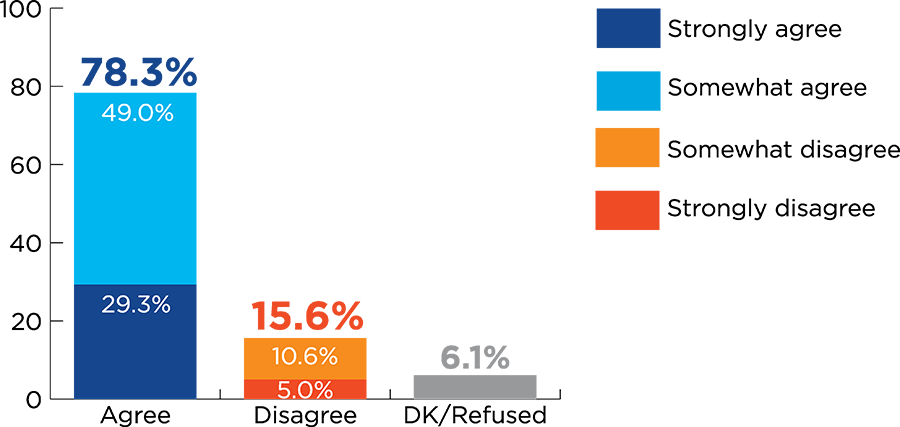
Some Idahoans worry about a potential “brain drain” of Idaho graduates – that is, the belief that many Idaho students opt to leave the state upon graduating high school to seek higher education or employment elsewhere. To see how widespread this belief is, we asked Idahoans: when Idaho students graduate high school do they leave to live and work in other states or do they stay to live and work in Idaho? Idahoans are split in their expectations. Approximately 41% believe that Idaho graduates leave the state, while 36% believe they stay. Almost a quarter (23%) were unsure. The belief that graduates leave was more pronounced in the areas neighboring Spokane and Idaho Falls than in other areas of the state. Similarly, longtime residents of Idaho are more likely to think that graduates leave (38%) than newcomers (26%).
Which of the following comes closer to your opinion?
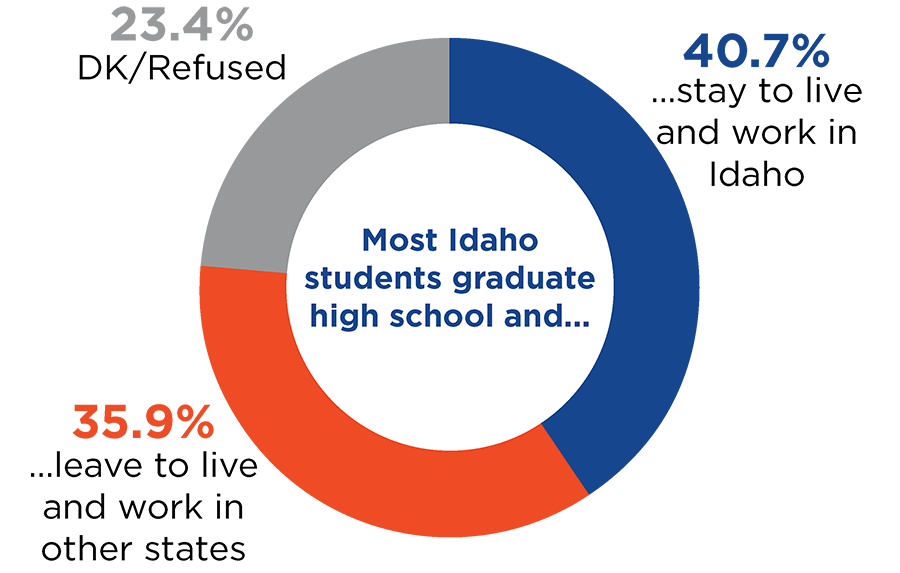
During a 2022 special session, the Idaho Legislature passed legislation transferring $330 million in sales tax collected to the K-12 public school fund. With Idahoans’ overall education priorities already established with the earlier open ended question, we were interested in seeing what they considered the best use of that $330 million from a specific range of options. Increasing teachers’ pay (37%) was the most preferred response, followed by improving the curriculum of K-12 schools (21%) and reducing classroom sizes (17%). Rounding out the alternatives was adopting school choice (12%) and adding new technology to classrooms (8%).
In addition to being the top response overall, increasing teachers’ pay was also the top choice among all party identifications– Democrats (55%), Independents (38%), and Republicans (30%).
The State of Idaho is currently planning to invest $330 million in K-12 schools. Knowing that, which of the following do you think would be the best use of that investment?
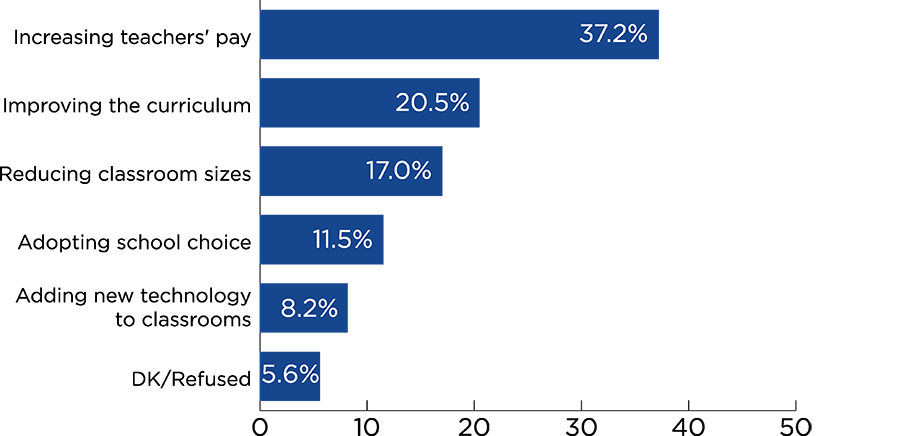
Growth, Housing, and Economic Situation
In recent years, issues surrounding growth, housing, and economic security have increasingly concerned Idaho residents, particularly in rapidly growing areas of the state like the Treasure Valley and Kootenai County. For a second consecutive year, we asked Idahoans whether they feel that the state of Idaho is growing too fast, too slow, or about right. Once again, two-thirds (67%) indicated that the state was growing too fast, a four-point decline over the previous year. A little under a quarter (24%) said it was growing about right, a three-point increase over last year that is just outside the margin of error, and only 5% said it was growing too slow, roughly the same as last year.
Regionally, Canyon County respondents were the most dissatisfied, with 84% saying growth is happening too fast. Even areas with the lowest proportion answering too fast – the Idaho Falls (61%) and Spokane (61%) media markets – still boasted clear majorities dissatisfied with the pace of growth. Longtime residents who have lived in Idaho for 10 years or longer were six-points more likely to say growth was happening too fast compared to those who moved to Idaho in the last 10 years.
Would you say that the state of Idaho is growing too fast, too slow, or about right?
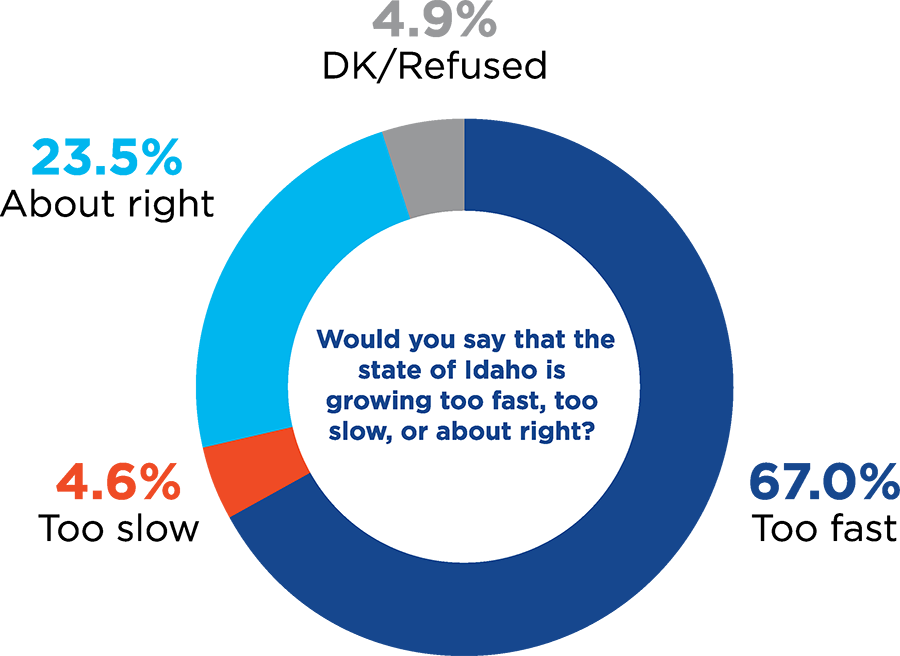
Idaho’s growth has impacted its housing markets, as well. Previous years of this survey have shown increasing concern among Idaho residents about housing and affordability, and while this year’s results show some improvement, that concern is still evident. When asked if they had to move out of their homes today, for whatever reason, how likely it would be that they would be able to purchase or rent a similar home for the same amount, over two-thirds (69%) said that it was unlikely (58% going so far as to say very unlikely). Only 29% of Idahoans said it would be likely they find a similar home (12% very likely). These numbers closely mirror what respondents said in 2022, with changes falling within the margin of error.
Home ownership impacted responses. While 66% of homeowners said finding a similar home for the same amount would be unlikely, this trailed 77% of renters saying the same. Similarly, 70% of longtime Idaho residents responded that finding a similar home would be unlikely compared to 63% of those who moved to the state within the last 10 years.
If you had to move out of your home today for whatever reason, how likely is it that you would be able to purchase or rent a similar home for the same amount?
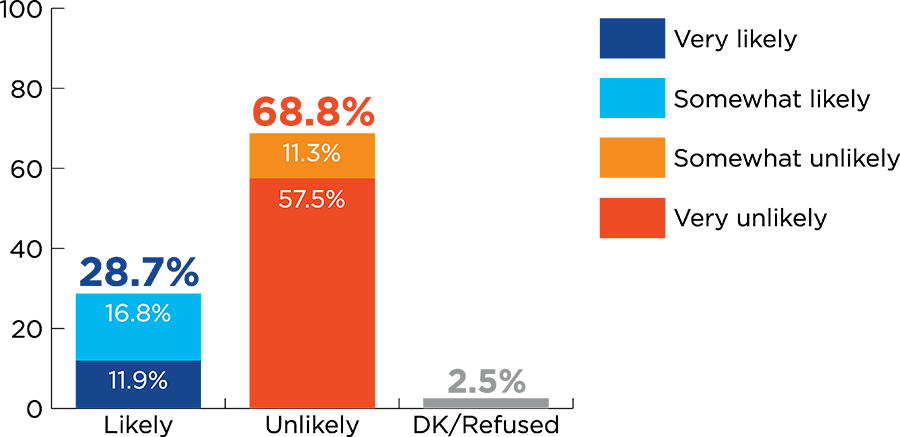
Some new questions this year concerned housing and economic stability. Approximately 22% of our sample currently rent their home. Among those renters, many have experienced rising costs across Idaho – 65% of renters said their rent has gone up in the past year, with 39% indicating it has gone up a lot. Almost a third of respondents (32%) said that their rents had stayed the same, while only 1% said it had gone down. Ada County was the most impacted area of the state, with 83% of its renters saying their rent had increased over the past year.
In the past year, has your rent gone up, gone down, or stayed about the same?
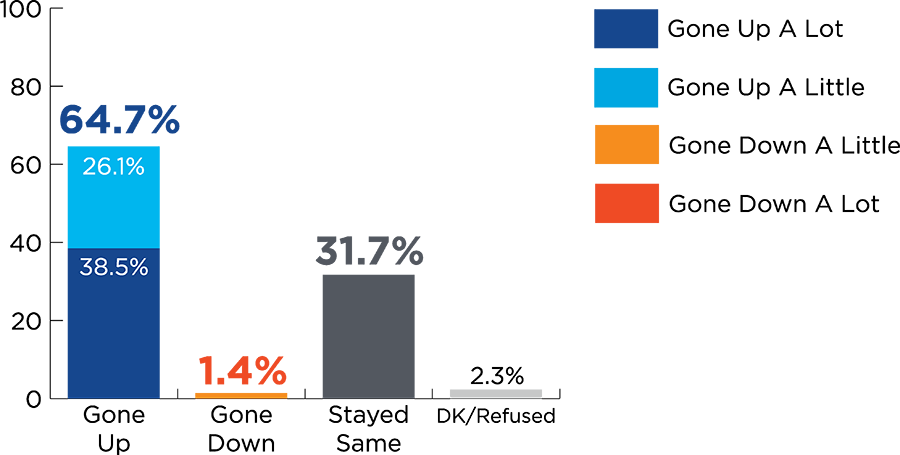
Other cost of living increases may also be impacting Idahoans, heightening worries about meeting monthly expenses. When asked how often the statement “I worry that my income won’t be enough to meet my or my family’s monthly expenses and bills,” described their state of mind, 43% said it was more than an occasional concern (21% always, 22% frequently). A little over a third (35%) said it was an occasional concern, while 21% said they never worried about monthly expenses or bills.
Renters were nearly twice as likely to say they were always or frequently worried about monthly bills (67%) compared to homeowners (35%). Concern was also more pronounced among the unemployed (90% always or frequently), disabled (74%), and students (64%).
How often does this statement describe your state of mind?
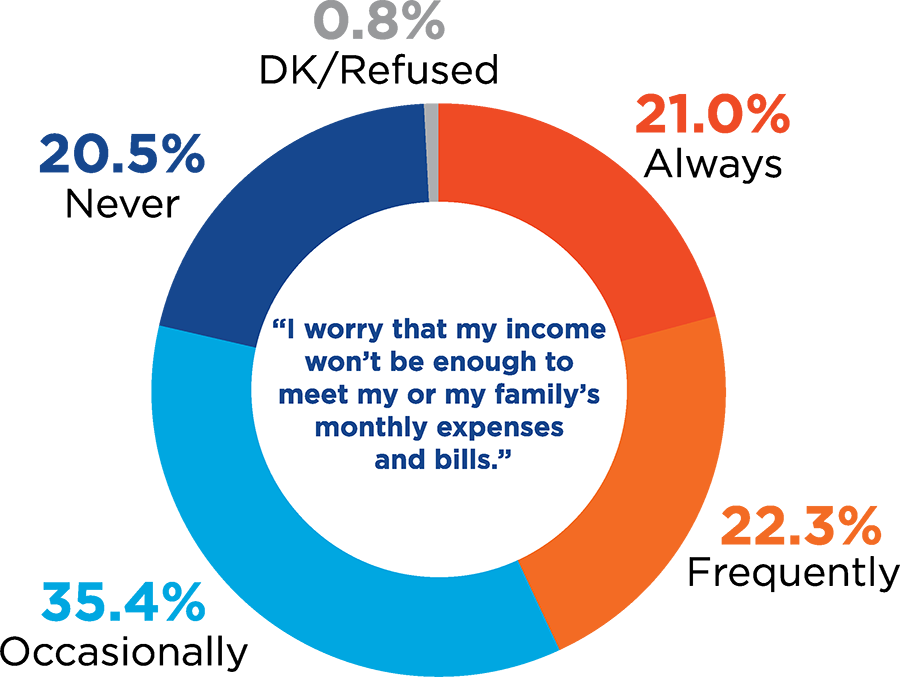
Gas prices are frequently used in national political coverage as a proxy for U.S. presidential approval, under the expectation that it may influence an individual’s vote. With little research available on the influence of gas prices on political behavior in Idaho, we were interested in gauging the effect they may have played in the November 2022 election. Approximately 30% of Idahoans said gas prices had a great deal of influence on their vote, while 17% said it had some influence and 9% only a little bit. Alternatively, 40% said it had no influence on their vote at all.
There is evidence of a partisan effect on one’s answer. While 62% of Republicans and 51% of Independents said it had at least some influence on their vote, only 16% of Democrats said the same– 75% of Democrats said it had no influence at all.
What influence did the price of gas have on who you voted for in November’s election?
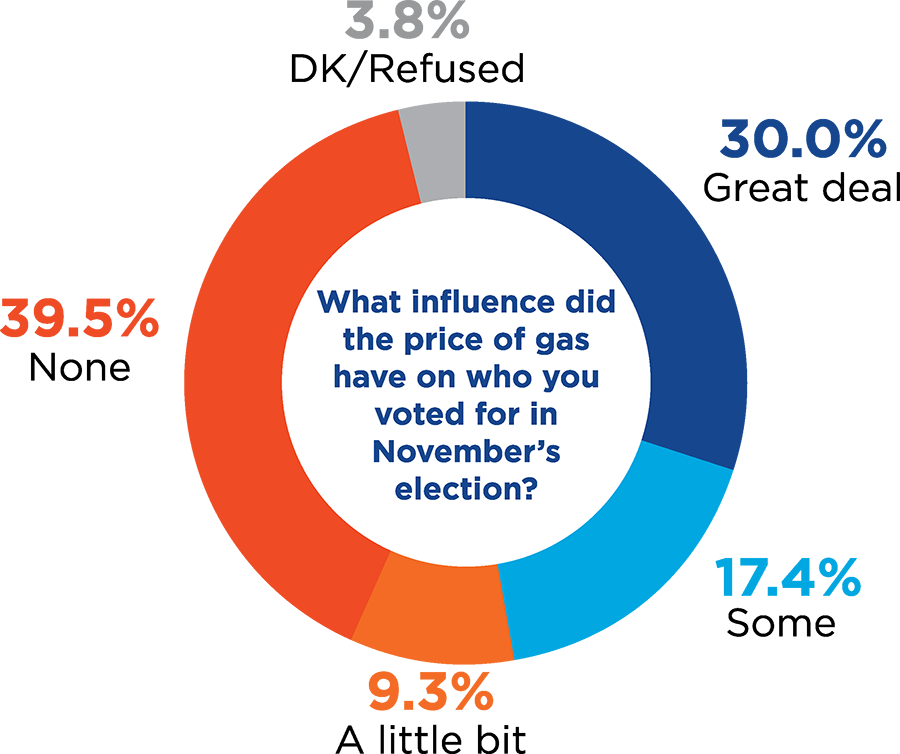
Many businesses and organizations have been exploring increased hybrid or work-from-home alternatives in recent years. While at first this was primarily a way of responding to the COVID-19 pandemic, an open question is whether these changes constituted a paradigm shift or if commuting habits would eventually “return to normal.” A little more than half of our sample (53%) reported being currently employed. Among Idahoans currently working, two-thirds (66%) say they commute to work full time, while 13% work from home full time– 20% alternate their time between commuting to work and working from home.
While this is the first time this question has been asked statewide, trends at the Treasure Valley level indicate that the proportion of people working from home full time has nearly halved in recent years, while commuting and hybrid schedules have become more common.
[Among those currently employed…]
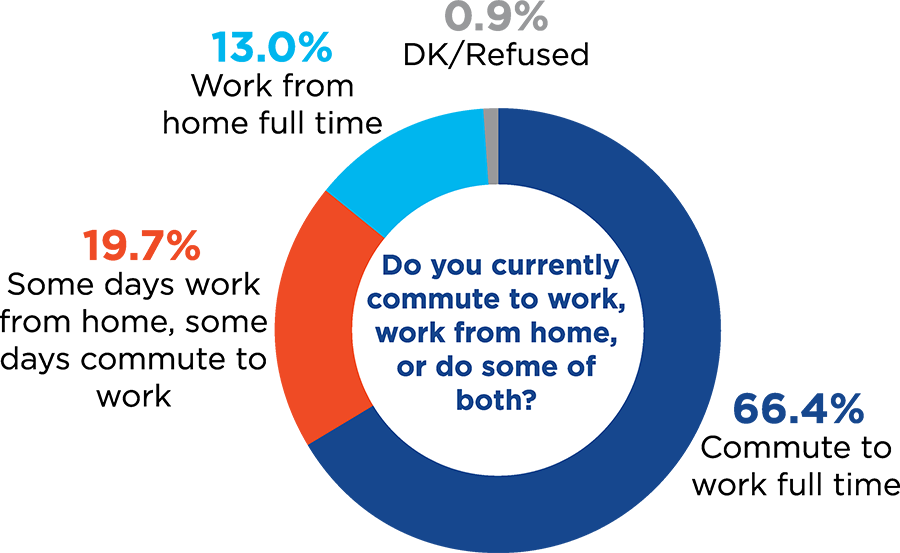
Environment
Environmental, Social, and Governance (ESG) scores are a concept that has increasingly been the subject of policy conversations. An ESG score can include factors like the record of a business on the environment, diversity, and business transparency. While most banks in Idaho do not currently consider a company’s ESG performance when making a loan, there is some discussion surrounding whether they should be able to. When asked, most Idahoans are split on the issue– 40% say banks should be able to consider a company’s ESG performance when determining eligibility for a loan, while 39% say banks should be banned from doing so. A sizable proportion of Idahoans (21%) were unsure on the question, indicating that ESG may not be a concept many are familiar with.
A majority of Republicans (53%) said banks should be banned from considering ESG scores, while a majority of Democrats (66%) said they should be able to consider them. Similar to the overall results, Independents were more split between allowing the use of ESG scores (38%) and banning them (43%).
You may have heard of the term ESG, or Environmental, Social, Governance performance. ESG includes factors like the record of a business on the environment, diversity, and business transparency. Most banks in Idaho do not currently consider a company’s ESG performance when making a loan. Knowing that, which of the following comes closer to your opinion?

Salmon recovery efforts have received much attention in Idaho the last several years. While proposals to remove dams on the lower Snake River have been a primary focus, a wide range of salmon recovery strategies are being discussed. In order to measure public receptiveness to these efforts, we asked Idahoans how important they considered the recovery of salmon populations in Idaho. A substantial majority of Idahoans (80%) said they considered it important (44% very important), compared to 13% who considered it not important.
In your opinion is it very important, somewhat important, not very important, or not at all important to recover salmon populations in Idaho?
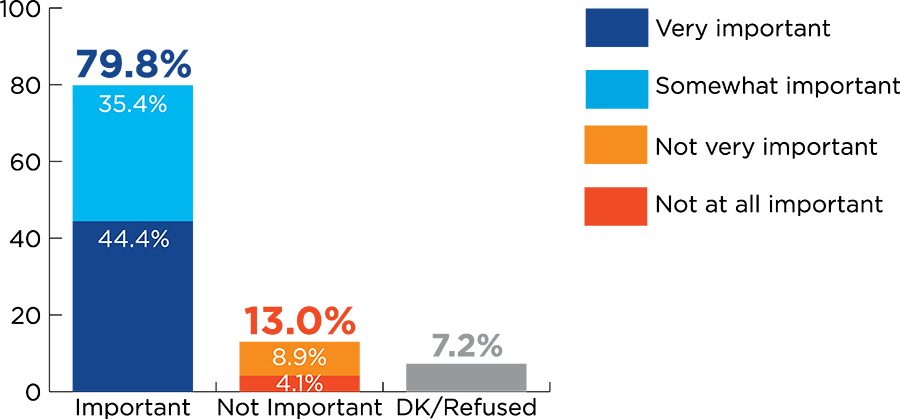
When presented with specific salmon recovery strategies and asked which should be the top priority of efforts, habitat restoration (29%) received the most support, followed by infrastructure change to improve passage (24%) and management of hatcheries and harvest (23%). A distant fourth in terms of prioritization was increased public outreach and awareness (8%). Idahoans who viewed salmon population recovery as important were more likely to favor habitat restoration as a strategy (33%), while those who viewed salmon recovery as not important were more likely to favor management of hatcheries and harvest (45%) over other strategies.
There are many strategies for recovering salmon populations in Idaho. Which of the following do you think should be the top priority in salmon recovery efforts?
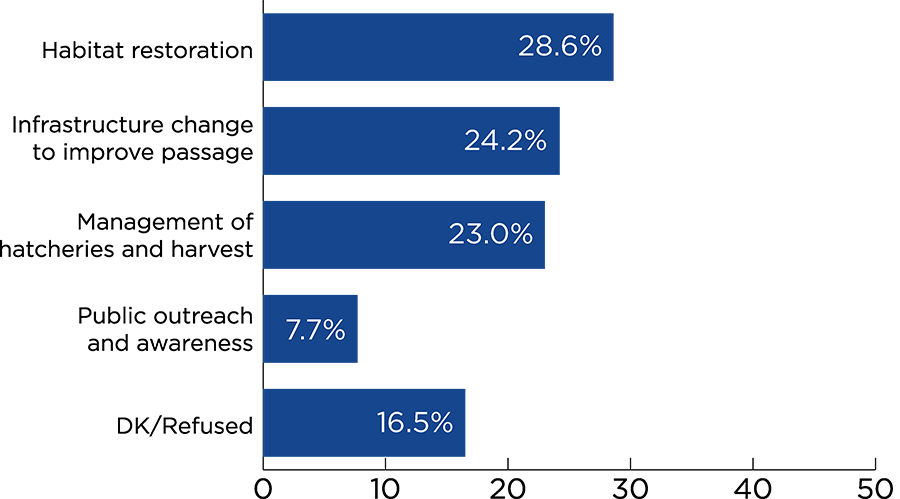
Crime
According to the FBI’s Uniform Crime Reporting (UCR) program, in 2021 there were approximately two violent-crime incidents per 1,000 people in Idaho and nine property-crime incidents per 1,000 people, but these data only include crimes known to the police. In order to better assess Idaho’s victimization and reporting rate, we asked Idahoans if they had been the victim of a property or violent crime in the past year. While a majority of respondents (87%) indicated that they had not, 7% said that they had been the victim of a property crime, 3% the victim of a violent crime, and 2% the victim of both a property crime and a violent crime.
Have you been the victim of a property or violent crime in Idaho in the past year?
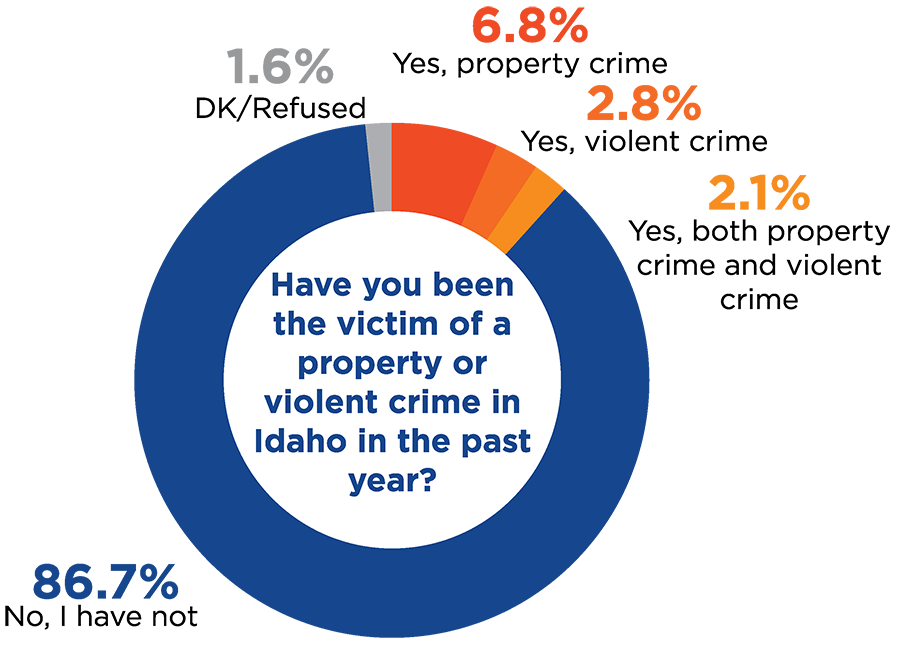
Among those who reported being the victim of a crime, 72% said they had reported it to the police, while 27% had not. Violent crimes were more likely to have been reported – 79% of those who experienced a violent crime and 76% of those who experienced both a violent crime and property crime said they reported it. Conversely, only 68% of those who experienced property crime reported the incident.
Did you report the crime (or crimes) to the police?
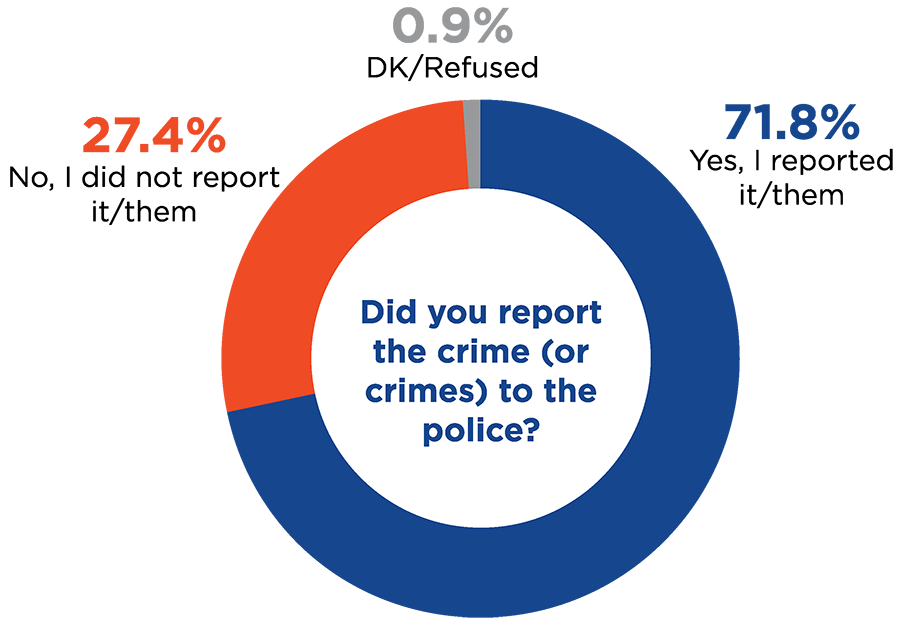
Several resources are available for victims of crime, including counseling, support groups, victim compensation, or help with the criminal justice process. Among those who reported being the victim of a crime, 37% reported receiving some form of assistance, while a majority (62%) did not. Those who were victims of a violent crime (61%) or of both a violent and property crime (43%) were more likely to report receiving assistance than those who were victims of a property crime (25%).
Did you receive any assistance – such as counseling, support groups, victim compensation, or help with the criminal justice process – from an agency or organization after being the victim of a crime?
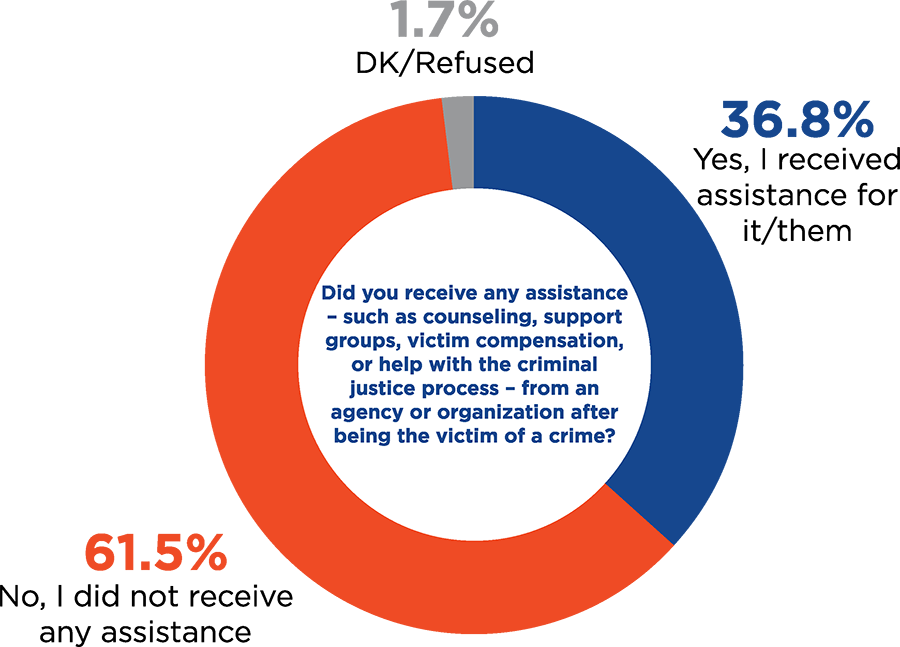
We also asked Idahoans to rate their overall level of trust in the Federal Bureau of Investigation (FBI) itself. A majority of Idahoans (52%) said they trusted the FBI (22% strongly trusted), while a little less (39%) said they distrusted it (25% strongly distrusted). This is generally in line with national polls, which finds FBI favorability at 50% and unfavorability at 46%. That said, political affiliation strongly impacted Idahoans’ responses. While majorities of Democrats (83%) and Independents (57%) indicated they trusted the FBI, a majority of Republicans (56%) said they did not.
Please indicate whether you strongly trust, somewhat trust, somewhat distrust, or strongly distrust the Federal Bureau of Investigation, otherwise known as the FBI?
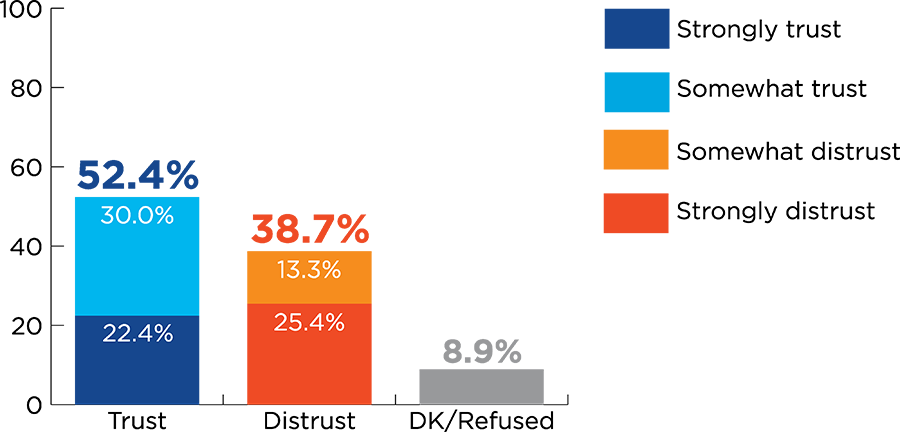
Conclusion
As in years past, this eighth edition of the Idaho Public Policy Survey has explored Idahoans’ attitudes and preferences on a wide range of policy issues facing the state. It has deepened our understanding of some long standing issues, allowed us to identify trends over time, and helps illuminate where many Idahoans are still divided between policy alternatives. It is also useful in identifying some rising economic concerns and growing pessimism among Idaho residents about the future. As always, it remains important to understand the changing attitudes and opinions of Idahoans as policymakers continue to navigate the challenges of meeting the interests and concerns of their constituencies.